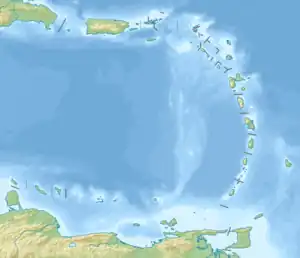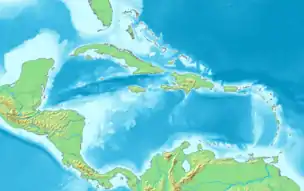| Anegada Passage | |
|---|---|
 Map of the British Virgin Islands, with the Anegada Passage labeled at right side. | |
 Anegada Passage  Anegada Passage | |
| Coordinates | 18°22′41″N 63°50′15″W / 18.37806°N 63.83750°W |
| Basin countries | British Virgin Islands Anguilla |
| Max. length | 200 kilometres (120 mi) |
| Max. width | 65 kilometres (40 mi) |
| Average depth | 2,300 metres (7,500 ft) |
The Anegada Passage /ˌænəˈɡɑːdə/ is a strait in the Caribbean that separates the British Virgin Islands and the British ruled Sombrero Island of Anguilla, and connects the Caribbean and the Atlantic Ocean. It is 2300 m deep. Because the threshold depths are 1800 and 1600 m, Atlantic deep water from 1600 m level may flow into the deep areas in the Caribbean Sea.[1]
The Anegada Passage is a key shipping lane for the Panama Canal.[2] Often called the "Oh-my-god-a Passage",[3] it is considered a difficult passage for sailors because of the winds, waves, and swells.[4]
The Anegada Trough
The passage consists of multiple basins and ridges. The Anegada Trough or Virgin Islands Basin was the likely site of the 1867 Virgin Islands earthquake and subsequent tsunami.[5][6]
See also
References
- ↑ "Anegada Passage". Encyclopedia Britannica. Retrieved 1 August 2018.
- ↑ "The World Factbook". CIA. Retrieved 1 August 2017.
- ↑ "The "Oh-my-god-a Passage"". Motivator. Retrieved 1 August 2017.
- ↑ "Anegada Passage". SV Party of Five. Archived from the original on 1 August 2018. Retrieved 1 August 2018.
- ↑ "Significant Earthquake". NOAA. Retrieved 1 August 2018.
- ↑ Barkan, R.; Ten Brink, U. (2010). "Tsunami Simulations of the 1867 Virgin Island Earthquake: Constraints on Epicenter Location and Fault Parameters". Bulletin of the Seismological Society of America. 100 (3): 995. Bibcode:2010BuSSA.100..995B. CiteSeerX 10.1.1.544.6624. doi:10.1785/0120090211.